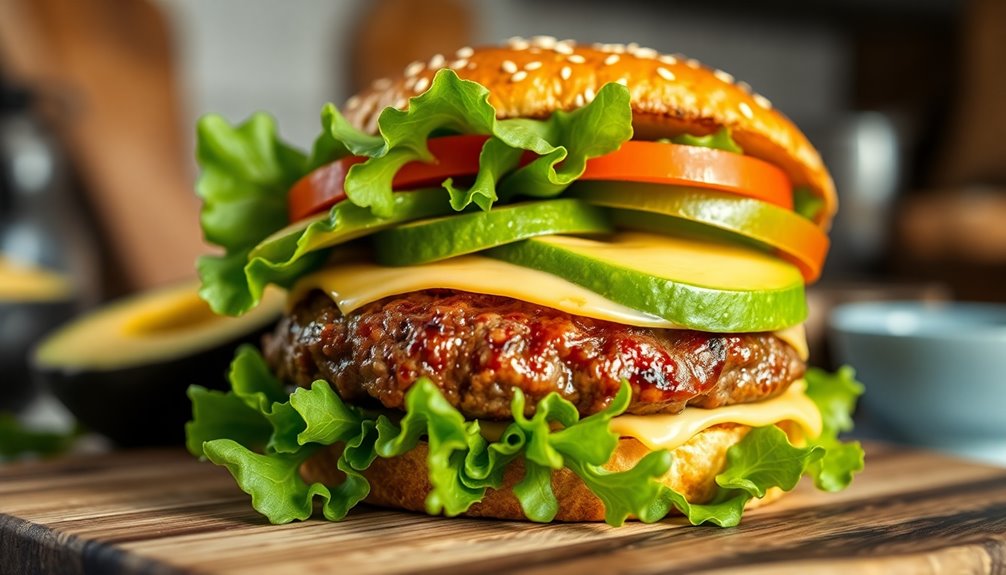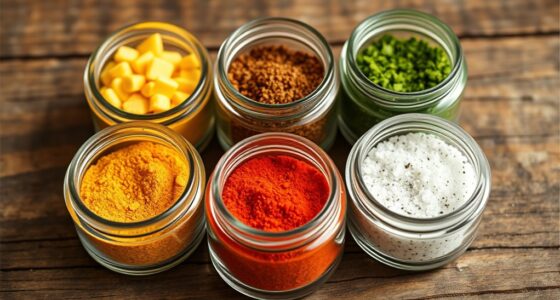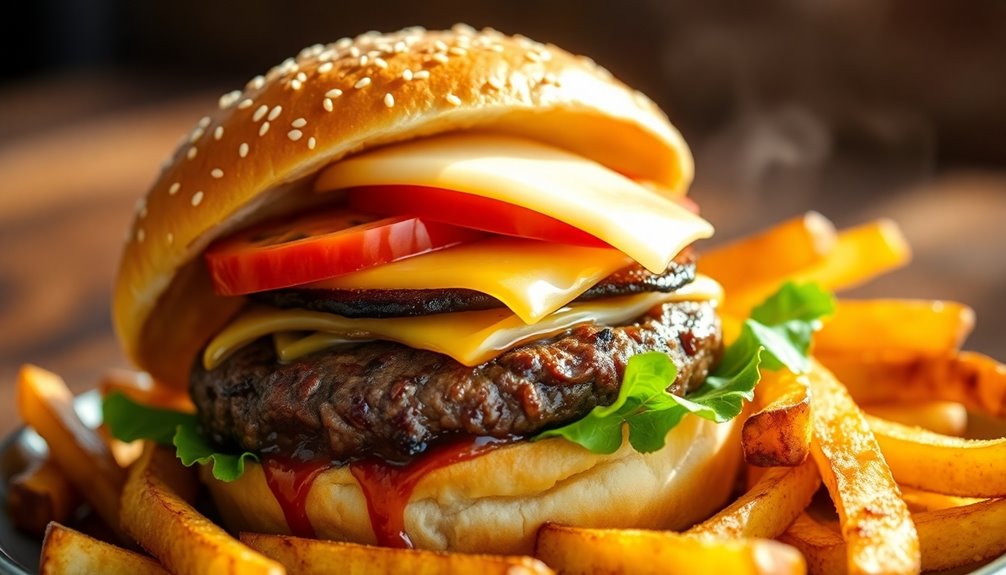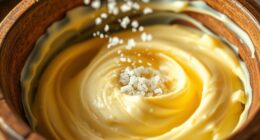Frying cheese curds in butter offers a rich, creamy flavor with a tender, less crispy crust, while oil creates a crisp, golden exterior with a neutral taste that highlights the cheese. Butter provides warmth and depth through its aroma, but it may result in softer textures. oil locks in cheese melt with satisfying crunch. Keep exploring to discover tips on achieving perfect results with each method.
Key Takeaways
- Butter imparts a rich, creamy flavor and enhances cheese melt, while oil provides a neutral base emphasizing cheese taste.
- Oil creates a crisp, golden exterior with a crunchy texture; butter results in a softer, tender crust.
- Higher frying temperatures in oil lock in cheese melt and produce a satisfying crunch; butter uses lower heat for a melt-in-your-mouth texture.
- Butter adds indulgence and depth through a buttery aroma; oil offers a cleaner taste with less greasiness.
- Nutritionally, butter increases saturated fats and calories more than oil, which may contain trans fats depending on the type used.
Flavor Profiles: Comparing the Taste of Oil and Butter Frying
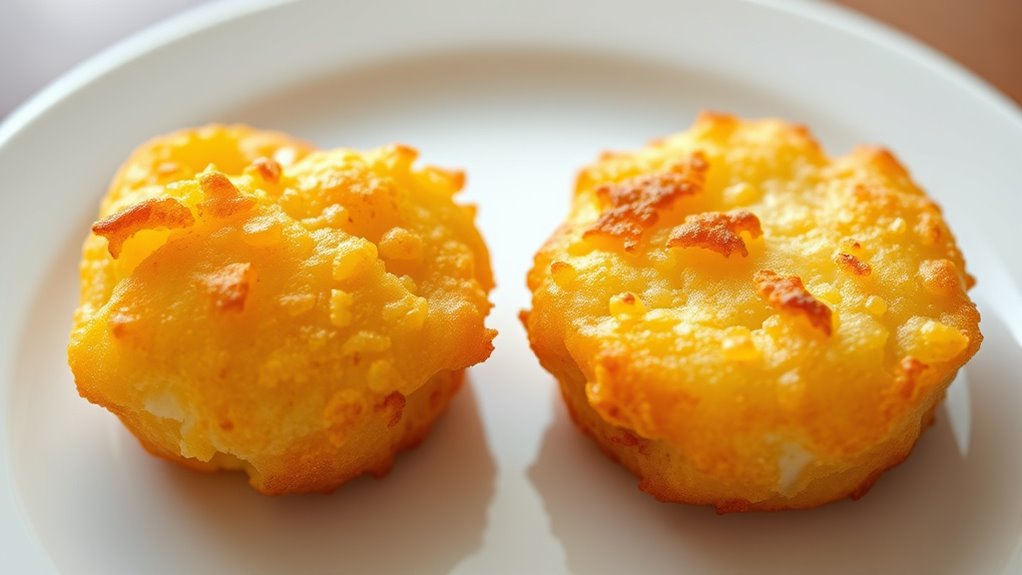
When you fry cheese curds in oil versus butter, you’ll notice distinct differences in flavor that can influence your overall taste experience. Cooking in butter offers a rich, creamy undertone that enhances the cheese’s natural flavor, creating a more indulgent taste. It also promotes a better cheese melt, making the interior gooey and satisfying. The buttery aroma adds warmth and depth, amplifying flavor enhancement with each bite. On the other hand, oil provides a neutral base that allows the true cheese flavor to shine, resulting in a cleaner, less greasy taste. While oil’s high heat can produce a crisp exterior, it tends to be less expressive in flavor compared to butter. Ultimately, your choice impacts both the cheese melt and the overall flavor profile, shaping your cheese curds experience. Additionally, the cooking medium can influence the texture and aroma, further affecting the overall sensory experience.
Texture Differences: Crispy Exterior and Melty Interior

Frying cheese curds in butter or oil produces noticeable differences in their texture, particularly in the exterior and interior. When fried at the right frying temperature, oil creates a crisp, golden exterior that holds the cheese melt inside, giving a satisfying crunch. Butter, however, tends to produce a softer, more tender crust that remains less crispy but enhances the meltiness of the cheese. The frying temperature influences this contrast; higher temperatures quickly crisp the exterior, locking in the cheese melt, while lower or slower heat results in a more delicate crunch. Overall, oil-fried curds offer a crunchier exterior, while butter-fried curds provide a tender, melt-in-your-mouth experience. Both methods highlight different textural qualities of the cheese. Additionally, maintaining a consistent frying temperature is crucial for achieving optimal texture quality and preventing uneven cooking.
Cooking Process and Technique Variations

The success of butter-fried cheese curds largely depends on the technique you use, as small adjustments can substantially impact texture and flavor. First, pay close attention to frying temperature; maintaining a steady 350°F to 375°F ensures the curds cook evenly without becoming greasy or burnt. If the temperature’s too low, the coating absorbs excess oil, resulting in sogginess; too high, and the exterior burns before the inside melts. When it comes to seasoning techniques, sprinkle salt or spices either before frying for a more integrated flavor or immediately afterward for a burst of seasoning. Experiment with herbs or pepper in the batter for added depth. Precise control over frying temperature and thoughtful seasoning are key to achieving perfectly butter-fried cheese curds. Additionally, proper storage of cheese curds before frying can help maintain their freshness and optimal melting properties.
Health Considerations and Nutritional Impact
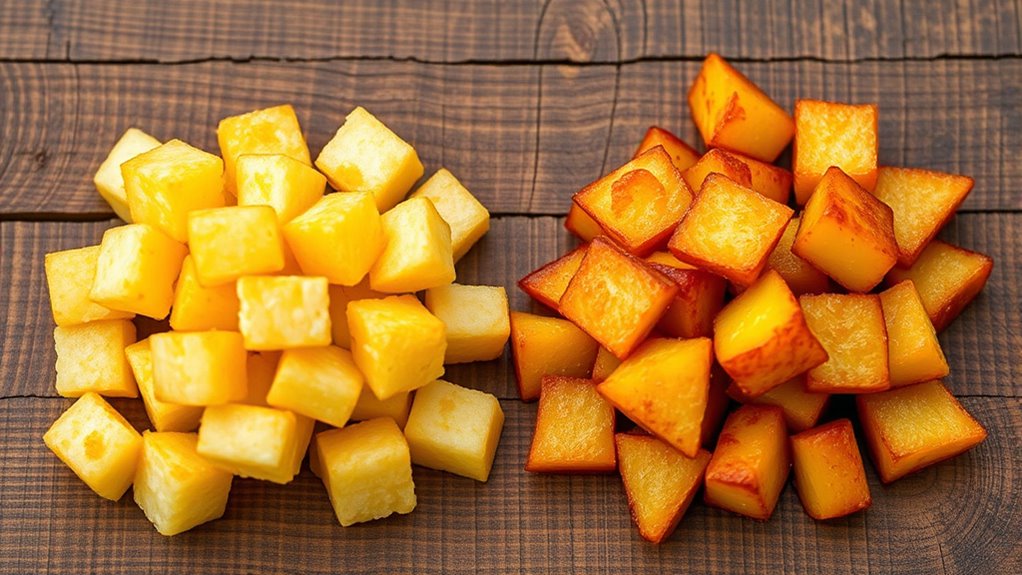
While mastering the perfect butter-fried cheese curd involves attention to cooking techniques, it’s also important to contemplate their health implications. A nutritional comparison reveals that butter adds saturated fats and calories, which may impact heart health if consumed excessively. Conversely, oil-based frying can introduce trans fats or unhealthy oils, depending on the type used. Both methods increase fat content and calorie density, but butter offers more flavor and richness. Consider portion size and frequency of intake to minimize negative health impacts. If you’re mindful of your diet, balancing indulgence with moderation is key. Ultimately, understanding the nutritional differences helps you enjoy cheese curds without compromising your health goals.
Tips for Achieving Perfect Butter-Fried Cheese Curds
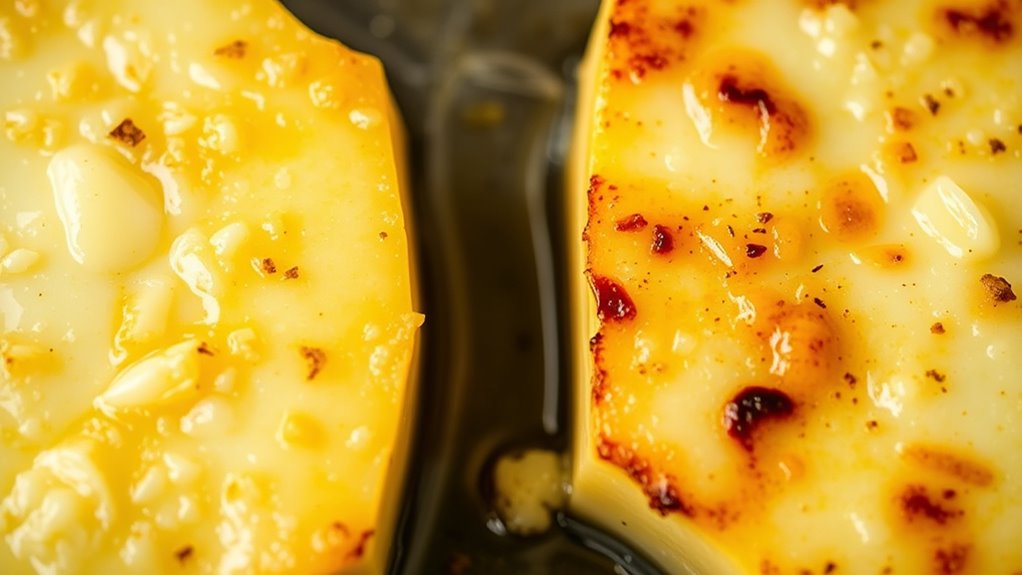
Achieving perfect butter-fried cheese curds requires attention to temperature control and timing. Use medium heat to ensure the cheese melts evenly without burning the butter. Choose cheese curd varieties like white cheddar or curds with a firm texture for better frying. To enhance flavor, pair your curds with dipping sauces such as spicy ranch or honey mustard. Keep a close eye on the frying process to prevent overbrowning or undercooking. Proper frying techniques are essential for achieving the ideal crispy exterior and gooey interior. Use the table below to help you select the right cheese and frying method:
| Cheese Curd Varieties | Ideal Dipping Sauces |
|---|---|
| White Cheddar | Spicy Ranch, Marinara |
| Pepper Jack | Honey Mustard, Buffalo Sauce |
| Mild Cheddar | Sweet Chili, Garlic Aioli |
| Colby | Classic Ketchup, Aioli |
Frequently Asked Questions
Which Method Yields the Most Authentic Cheese Curd Flavor?
You want the most authentic cheese curd flavor, so consider how each method impacts cheese melting and oil absorption. Frying in butter enhances the rich, cheesy taste because it creates a savory crust without excessive oil absorption, preserving the cheese’s natural flavor. Using oil might produce a crisp exterior but can dilute the cheese’s authentic flavor due to higher oil absorption. For true cheese curd flavor, butter-frying typically wins.
How Does Frying Temperature Influence the Final Taste?
Imagine the contrast between a perfectly golden crust and a burnt, bitter flavor—frying temperature controls this balance. When you maintain precise temperature control, you allow flavor development without overcooking, ensuring the cheese curds stay tender and flavorful. Too high, and you risk burning; too low, and you get greasy, undercooked results. By managing temperature carefully, you release the best taste and texture in your cheese curds.
Can Butter-Fried Cheese Curds Be Made Vegan?
Yes, you can make vegan cheese-fried curds by using dairy alternatives like vegan cheese. Simply replace traditional cheese with plant-based options, and fry them in oil or plant-based butter for flavor. You might want to experiment with different vegan cheeses to find the best melt and taste. This way, you enjoy a delicious, dairy-free version of fried cheese curds without sacrificing flavor or texture.
What Are the Best Types of Cheese for Frying?
When choosing cheese for frying, you want varieties with good melting qualities and stable cheese aging. Mozzarella is a top pick because it melts smoothly and stays gooey, making it perfect for frying. Provolone and fontina also work well due to their excellent cheese melting properties. Hard cheeses like Parmesan aren’t ideal because they don’t melt well, but their cheese aging gives them flavor. Opt for fresh, high-moisture cheeses for best results.
How Does Frying Time Affect Cheese Curd Consistency?
You’ll notice that frying duration directly impacts cheese curd consistency. If you fry them too long, the texture becomes overly crispy or even rubbery, losing that perfect gooey center. Shorter frying times allow for better texture development, keeping the cheese soft and melty inside while the outside turns golden. Monitoring the frying duration helps you achieve that ideal balance, ensuring your cheese curds are crispy on the outside and irresistibly gooey on the inside.
Conclusion
So, whether you prefer the rich, savory notes of butter or the neutral crispiness of oil, both methods bring something special to your cheese curds. Do you want a buttery, melt-in-your-mouth experience or a lighter, crunchier bite? Ultimately, it comes down to your taste and texture preferences. Whichever you choose, mastering these techniques guarantees a delicious treat. Why not try both and discover which side steals your heart?



